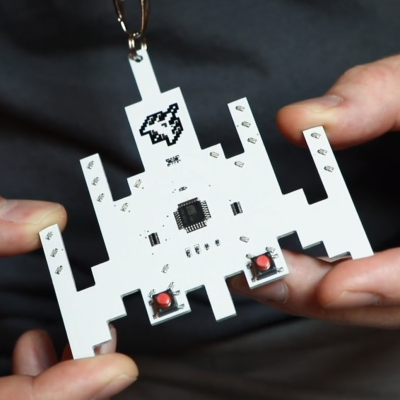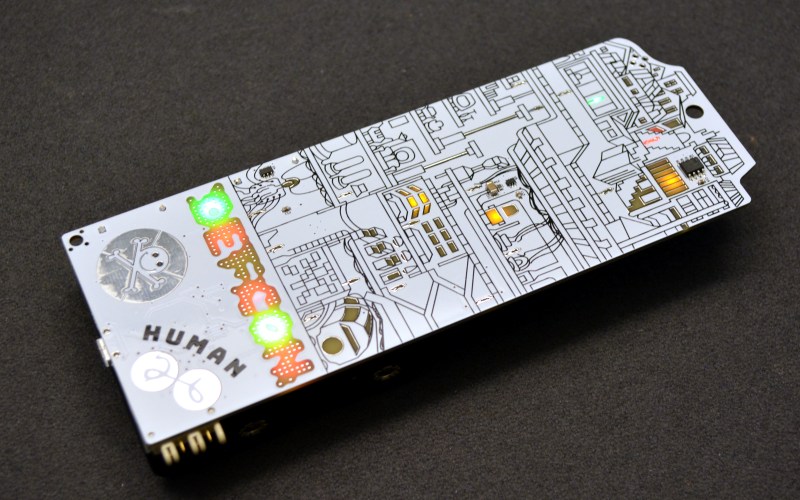Last week, tens of thousands of people headed home from Vegas, fresh out of this year’s DEF CON. This was a great year for DEF CON, especially when it comes to hardware. This was the year independent badges took over, thanks to a small community of people dedicated to creating small-run hardware, puzzles, and PCB art for thousands of conference-goers. This is badgelife, a demoscene of hardware, and this is just the beginning. It’s only going to get bigger from here on out.
We were lucky enough to sit down with a few of the creators behind the badges of this year’s DEF CON and the interviews were fantastic. Right here is a lesson on electronic design, manufacturing, and logistics. If you’ve ever wanted to be an engineer that ships a product instead of a lowly maker that ships a product, this is the greatest classroom in the world.
Although badgelife may seem like a bunch of hardware engineers sitting behind a pick and place machine for a weekend’s worth of lulz, this is a masterclass of product design and manufacturing. Badgelife is product development, and unlike many other hardware design jobs, the ship date will not slip for any reason. The hardware must be done on time, and if you’re not shipping all the features you promised everyone will be upset. Badgelife is the best experience you’ll ever get in engineering for production, product design, and manufacturing.
The Greatest, and Most Coveted Badge
One of the most coveted badges at this year’s DEF CON was the one from AND!XOR. This team of engineers consisting of [zapp], [Hyr0n], [Bitstr3m], [8bit] and a few others have been creating independent badges for three years now. Their Bender badges are consistently held up as the example of what badgelife is all about: custom hardware turned into art on a tight production schedule. How do they do it? Effectively, they work backwards. Instead of throwing a microcontroller and some art on a board, they first figure out what they want the badge to do, and select their parts from there. The cost of prototyping, the number of expected failures, and the total cost of goods sold is all taken into account before the design is finalized. Only then do they make the prototypes and reach out to Kickstarter to fund the rest of the production run. This year was exceptional in that regard: AND!XOR sold 300 of their fantastic Bender badges overnight. Hundreds more were sold at the con.
The Official Badge
When it comes to manufacturing challenges, there’s no comparison to the main DEF CON badge. This year, the official badge was brought to life by a hardware collective known as Tymkrs. DEF CON reached out to the Tymkrs after seeing their incredible cubic badge from last year’s Cyphercon, and after months of work the Tymkrs managed to ship over 28,000 badges for this year’s DEF CON.
The theme for this year’s DEF CON, and this year’s DEF CON badge, is 1983, the year before the Orwellian hellscape of 1984. This is the year where it was still possible to change something, even though Oceania had always been at war with Eastasia. This idea gave the Tymkrs an idea for a game in the badge, where your choices affect those around you. This is done by ‘mating’ different badge together through a hermaphroditic connector. Plug two badges into each other, and it affects the status of each badge.
If there’s one problem with manufacturing 28,000 of something, it’s programming the microcontroller on every board. The best way to program thousands and thousands of chips is to have them programmed off the assembly line. For any DEF CON badge with a production timeline of a few months, there simply isn’t time for that. The next option is to have the chips programmed before they’re put on a reel. This is what the Tymkrs planned to do, but three weeks before the con their supplier reached out and told them they had no idea how to program these microcontrollers. Without a moment to spare, the Tymkrs said to ship them to the fab in China, asked the factory to hire some temp workers, and had dozens of people programming badges as they came out of a reflow oven. If you’re wondering how high someone’s blood pressure can go, just ask the Tymkrs.
No One Says You Need To Ship Thousands

One of the stand-out badges of this year’s DEF CON was the Coin-Op badge from Hackaday Editor in Chief and Mister Hackaday himself, [Mike Szczys].
[Mike] has been involved in a number of badge projects before, from the 2017 Superconference ‘camera’ badge to the 2018 Belgrade retrocomputer badge, but he hasn’t gone deep and built a badge entirely by himself before. This changed with the Coin-Op badge, a badge inspired by the greatest video game ever, Galaga.
The design for the Coin-Op badge began on July 1st, and consisted of a Galaga ship-shaped board loaded up with LEDs and microcontrollers. [Mike] assembled almost sixty of these by hand in his basement by the end of the month, just in time for DEF CON. This was one of the great badges this year, and would have been in the running for the Badgelife contest if [Mike] wasn’t also tapped for his expertise as a badgelife contest judge. It just goes to show you don’t need to produce hundreds of badges — sometimes just a few dozen will make a huge impact.
It’s A Demoscene of Hardware
The rise of badgelife is one of the greatest advances in DIY hardware. This is the only place you’ll find people designing and manufacturing items on an extremely condensed time scale, all on their own. This is a demoscene of hardware, with dozens of groups showing off what they can do with limited resources and limited time. If the Commodore and Amiga demo shows are the top tier of software developers, badgelife is the Olympics for hardware engineers. This is it, and it’s only going to get better from here.


















I do not think that throwing some LEDs on a cartoon-shaped PCB compares to programming a crazy 80s computer to do things it wasn’t supposed to be able to do.
I think you’re comparing the simplest of badgelife to the most complex of 80’s demoscene. When a badge is the full package (initial concept, hardware design, software design, storyline/puzzle/interactivity, and all that goes around presenting the badge to the user) it’s a strong analogy.
I’m with Mike on the argument about technical complexity. Computer demos cover a wide gamut from simple to complex, from crude to slick, and all in between. I like the idea of hardware demos as an art form.
What bothers me, is the unilateral appropriation of the term demoscene itself. The demoscene is a subculture that formed and grew organically over many years. No one was declaring it into existence. No one gave it its name. And no one hyped it as the new incarnation of something else.
To me, self-declaring to be the demoscene of hardware smells like a marketing ploy to leech off the achievements of another group.
Call badgelife badgelife if you must, but let it grow on its own merits.
PS: I think badgelife is too narrow of a name anyways. IMO, the creations of Sprite_TM and the like are much closer to the classical demo spirit.
“To me, self-declaring to be the demoscene of hardware smells like a marketing ploy to leech off the achievements of another group.”
Yeah.
Not to mention the completely elitist requirement you be able to attend these largely self-congratulatory, self-referencing “security conferences”, which themselves are largely a practice in hucksterism, showboatism and taking credit for technical achievements many others actually deserve credit for.
But that is how the world works.
> largely self-congratulatory, self-referencing “security conferences”, which themselves are largely a practice in hucksterism, showboatism and taking credit for technical achievements many others actually deserve credit for.
No, that’s blackhat. There’s still some cool people at defcon.
To expand on that.. What was awesome about the demoscene was the total democratization of knowledge and skill it represented.
Physical location and largely economic circumstances had little impact on the participants – eastern european prodigies could compete against MIT students just fine.
The security conference scene is nearly the complete opposite of this.
I’ve seen articles here talking about the really cool electronic badges that conventions like this have. One thing I don’t understand, though, is how it actually works as a badge, as in, a form of identification and showing that you’re allowed to be there. And how the conference knows these are authorized badges, as opposed to just someone making a badge and walking in?
You’re confusing the official badges and all other badges. the others typically grant you access to private parties hosted by the groups who designed them.
I don’t think anyone actually uses it as a form of ID really, other than the fact that you have the thing so presumably you’re part of whatever group produced it.
Please stop glorifying this kickstared e-waste trend
“The rise of badgelife is one of the greatest advances in DIY hardware. This is the only place you’ll find people designing and manufacturing items on an extremely condensed time scale, all on their own. ”
FFS.
Maybe he’s saying it provides base load for the cheap PCB house ecosystem and hobby electronics in general LOL
Yea. I read that and cringed as well… Surely the diy community has achieved greater things than badges. I’m sure there are those individuals who go way beyond in their badge design but they certainly can’t produce those in great numbers, let alone enough to swap with everyone. Had anyone made any portable retro arcade badges yet? That would be cool and useful.
..A badge that has gaming functionality? What an original, inspirational idea.
Love the badges!
This is not a badge but it fits very well: https://www.youtube.com/watch?v=HHvwhJwrxEg
Hey, I didn’t get to go to Defcon because I had committed to make a fancy swag item for MAGwest. It seems like folks actually manage to *sell* the badges they make for Defcon.
Could somebody appraise the badge I made for MAGwest and tell me if it would be worth trying to sell at Defcon or elsewhere?
https://hackaday.io/project/160602-magwest-8-bit-blinky-heart-couples-pendant
> The people writing the libraries for the LED grids and LCDs and other ICs are the real heros
Okay, I wrote a library for a LED driver chip you couldn’t buy in April, using a non-standard layout that wasn’t in the datasheet. No one else has done anything with this chip yet. This chip is the easiest way to do an 18×18 LED grid, and it costs $3. There’s also a toolchain to import animated jifs and spit out code. All of this code is open source now.
> their contributions to DIY community truly are of the utmost importance
Thank you for your support.
U.S satellites carry most signals from worldwide DVB. https://www.ateac.com/
The law enforcement officer may also administer more than one field sobriety tests.
Afterr all, in a sense, we have been travelers
spending some time in a certain place, learning from it, as well as
perhaps leaving our own sense of understanding along with a little mark
inside places we’ve got visited. Before sentencing, punishment ffor any crime mayy not be specifically defined. http://www.lurayduilawyer.com/dui-toledo-oh